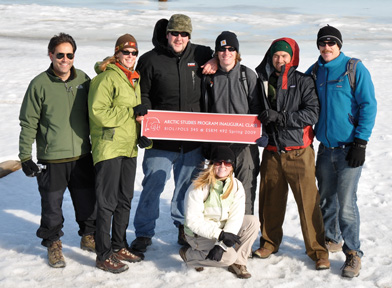Climate Change and the Arctic National Wildlife Refuge
By Amy Denton, Associate Professor of Biology

To most inhabitants of sunny Ventura County, the Alaskan arctic may seem an inhospitable snow-covered wasteland, but this seldom-visited region is a perfect natural laboratory in which to study the science behind, and policy issues surrounding, climate change.
In June 2009, we (Professor of Political Science Scott Frisch, Associate Professor of Biology Amy Denton, and adventurous CI undergraduates Ryane Cox, Mackenzie Douglass, Steve Harrison, Tim Moran, Lisa Myers, and Aaron Newton) traveled to Alaska as part of a study experience for a Science and Public Policy course (Biol/Pols 345) to take advantage of its unique situation as our nation’s only arctic state and the site of our largest petroleum reserves.
During our intensive nine-day field study experience, we observed the environmental, cultural, political, and economic impacts of fossil fuel extraction and consumption in arctic regions, and examined the relationship between these factors and climate change.
After a long day of travelling to 70 degrees north latitude and a hearty meal of reindeer stew and blueberry pie, we spent our first night under the midnight sun exploring the community of Deadhorse, a town built entirely of prefabricated modules established to support the drilling operations in nearby Prudhoe Bay.
Following a tour of the oil fields and processing facilities, as well as a visit to the still-frozen Arctic Ocean, we boarded a Cessna Caravan and flew to Kaktovik, a small Inupiat village where residents maintain a subsistence hunting culture and economy. Here, we had a chance to talk to local residents about the effects of the changing climate, but the whine of bush plane engines overhead signaled that it was time for us to leave civilization behind.
A breathtaking flight over the coastal plain brought us into the Arctic National Wildlife Refuge. Eight million acres of the Refuge are designated wilderness and this single protected area of linked arctic ecosystems is home to hundreds of species of mammals, fish, and migrating birds, many of which are being pushed toward extinction by warming temperatures.
We spent the next five days hiking across the tussocky tundra studying vegetation, wildlife, and geology in the Refuge as the annual migration of the Porcupine caribou herd began. In our remote camp on the banks of the Kongakut River, we slept in tents amid the willow scrub, shared cooking and chores, and marveled at the vast but fragile beauty of our surroundings. We spotted numerous caribou, ptarmigan, arctic terns, moose and a large brown bear. We were surprised to find so many colorful tundra flowers in bloom, perhaps another sign of a changing climate.
We flew out of the Refuge and over the Brooks Range in a dense, low fog. Conditions were challenging for our pilots, and Lisa, Tim and Ryane were fortunate to stop in the indigenous community of Arctic Village, where they were treated to an afternoon of conversation and fry bread with Gwich’in activist Sarah James.
Our adventure came to a close at the University of Alaska Fairbanks, where we hiked in the boreal forest and reflected on the rare opportunity we had to experience the Arctic National Wildlife Refuge.
